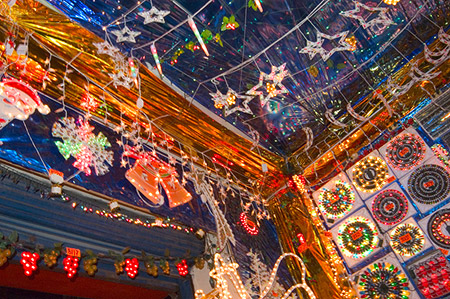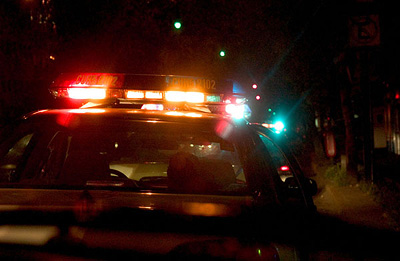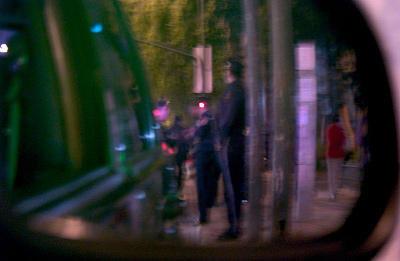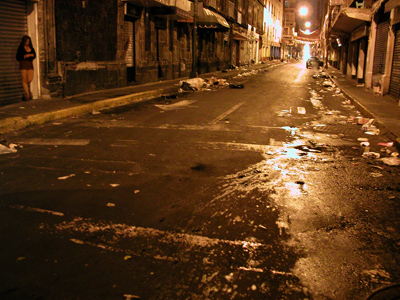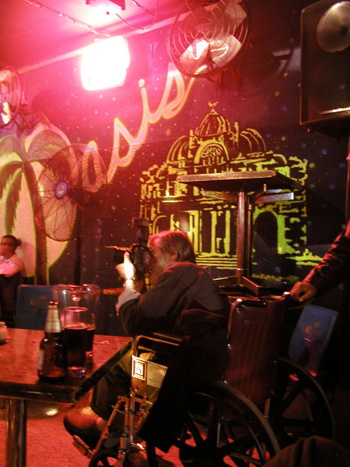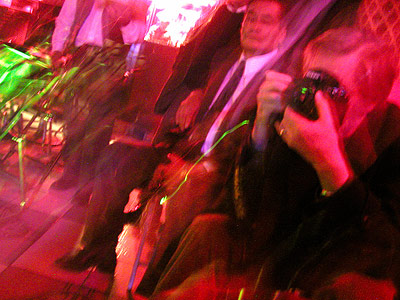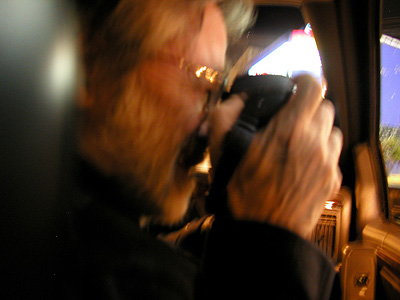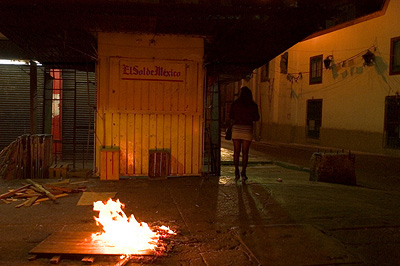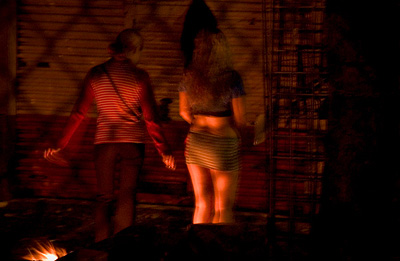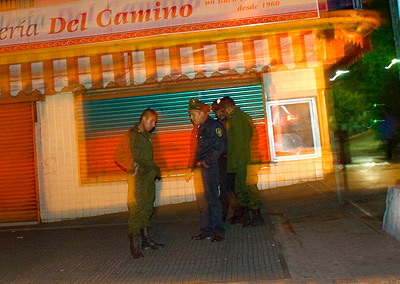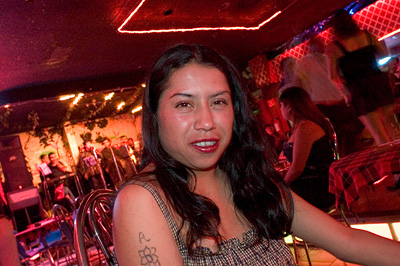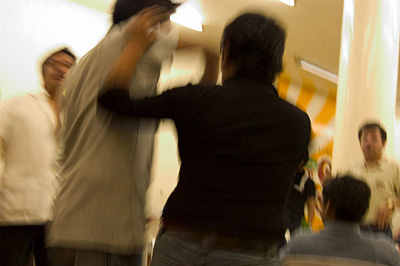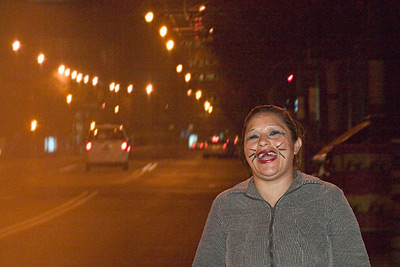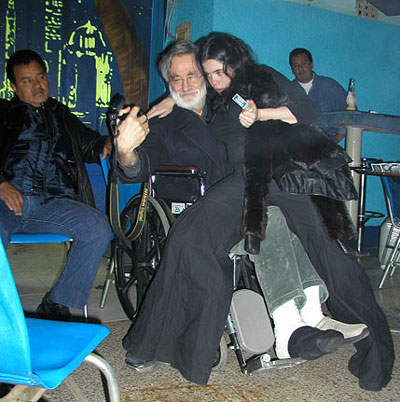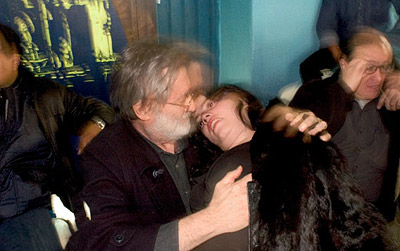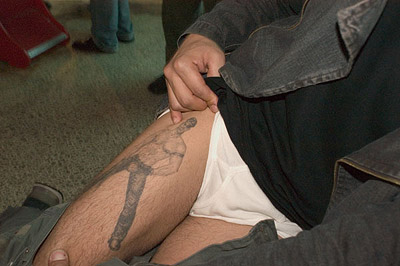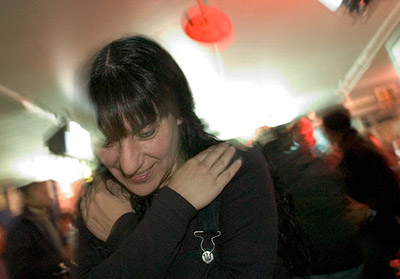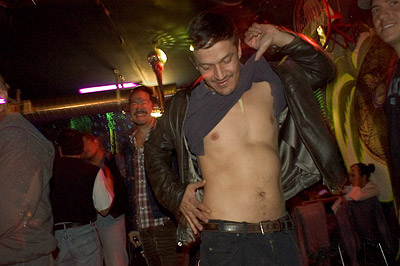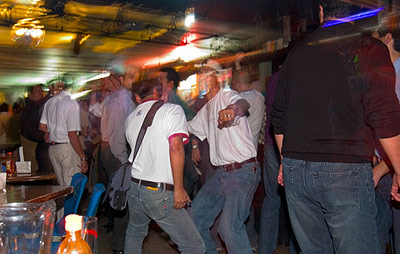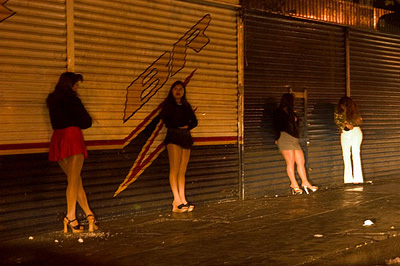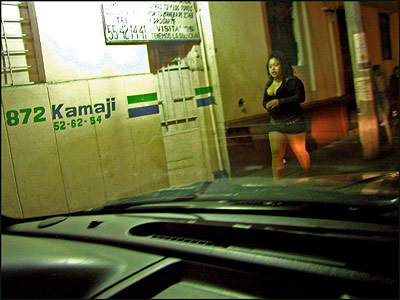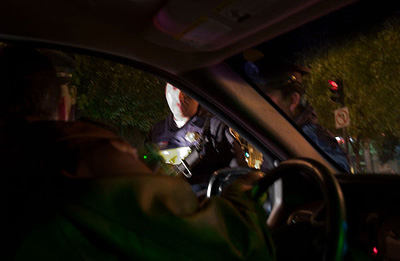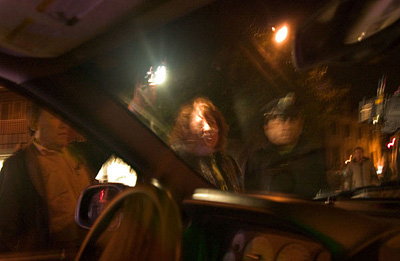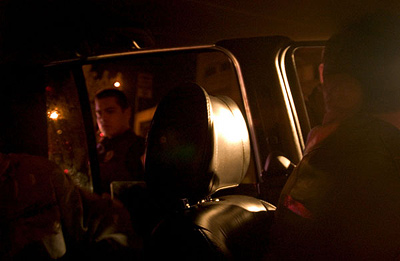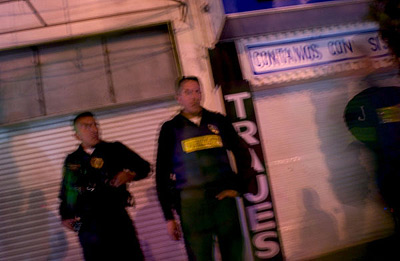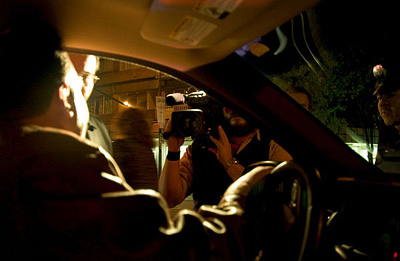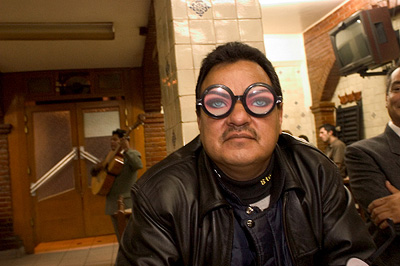Vanishing Evidences.
Photographing at night in Mexico City.
***
Pedro Meyer © 2003 |
QuickTime
6.4
plug-in is required
|
|
I had just been surrounded by 15 police cars. Their red and blue lights flashed, blinking all over the landscape at 1:30 in the morning. Surrounding my car, there were no less than 80 policemen, some of them boasting heavy duty machineguns that made the “Terminator” look like, well, just a governor of California. I must say that, if it had not been quite so real, this scenario looked pretty much like something out of a bad movie. What I am about to tell must be one of the most colorful stories told in a long time, combining the crossroads from analog to digital photography, sex, accidents and a lot of unforeseen twists and turns, that will prove to be quite worthy of an end of year finale.
I was comissioned by one of our main museums in Mexico City to produce a body of work for a permanent exhibition to be shown during the forthcoming five years. I would photograph the activities that take place in the city from 8pm to 6am. The inducement to cover those hours proved two fold for me. Not only did I find what went on during those hours very challenging, but I also knew that taking pcitures under poor lighting conditions and with digital technology would certainly be an interesting experience. Compared to what could be shot on conventional film, capturing images in weak lighting is quite something else. I have found that my digital cameras are much more responsive to low light than the counterpart cameras using film. And now, having a new Nikon lens, supported by a vibration reduction motor, I would be able to add 3 f stops. The new technology would offer amazing results.
However, I would have to confront one major problem. Going around the city during those hours of the night and in the rough neighborhoods I was to visit was not precisely what anyone would consider a safe situation, either for myself or for the photographic equipment I was to take along. I had absolutely no desire to be mugged or of being separated from my digital cameras. For this very same reason, I asked the museum director if the Police Department of the city would be able to provide two undercover agents that could offer me assistance and protection during the week I would be taking the photographs. The Police Department showed great understanding and straight away offered to help me out because the project seemed quite interesting. I was thrilled. The project would begin the forthcoming week, all the pieces falling into place very neatly. Yet, for all the precautions I had taken, I was unequipped to deal with an unforeseen turn of events. Just before the project got underway, I suffered a major accident right in my own studio. As I was setting up some sound equipment on the rear side of a G5 Mac that had just arrived, my foot got caught between some wires as I was leaving the back-side of the desk. I fell down, with a broken Achilles’ heel which now would have to be operated on. The ripped tendon would have to be stitched back together again. My foot was placed in a cast so I would not be able to move it or to even step on it. I was constrained to a wheel chair for the forthcoming three months. This scenario did not seem promising at all for the type of photography I had planned. However, after feeling sorry for myself during a couple of days, I decided I would not let this accident derail me from this project. And so, I started to view the problem from a different perspective. I knew now that the images would necessarily have to be different from those I would have been able to shoot under normal conditions. I did not quite know what this meant, although I could imagine some of the probable images. I would have to rethink the angle and height from which I would be photographing now, under these new circumstances. I could easily imagine that the dynamics of what could happen in any place I would visit, would also have to change due to the fact of my arrival in a wheelchair, surrounded by a whole entourage of people. Instead of being the unobserved photographer, I now had to accept that I would be the focus of attention anywhere I went. Thus, I would have to re-plan everything. Naturally, this transformed the ideas I initially had in mind.
Taking into account that my activities would require new strategies, I invited various friends to join me in the realization of the project. To begin with, I asked one of my colleagues to take pictures of me during the process of photographing from a wheelchair. I asked yet another colleague to make sound recordings of the places we were to visit shortly. Thus, we would later be able to create audio-visual material of this experience. Other friends came along just for the fun of it and also to suggest places we could visit and in which I would be able to take photographs. All in all, sometimes our entourage consisted of up to seven people. As I could no longer drive for obvious reasons, I had a chauffer to drive my car who would also lend a hand pushing my wheelchair. Besides my own automobile, our entourage consisted of another car, an unmarked police vehicle driven by one of the two cops assigned to protect both me and my equipment. The other policeman came along with me in my car. Thus, we rode in a two-vehicle convoy. Obviously, owing to the wheelchair and the amount of people surrounding me, every time we entered to a place people would start asking who I was. It wasn’t hard for anybody to understand I had people ‘protecting’ me. I suppose I must have seemed kind of enigmatic for most people: There I was, sitting on a wheelchair, several cameras hanging from my neck. My friends offered different explanations to the locals once they struck up a conversation with them.
According to each particular situation, they would say I was either a famous movie director looking for sets for his next movie, a politician who was enjoying a voyeuristic experience having a night out in town, or a T.V. journalist filming a story for one of the television networks. Paradoxically, the one and only thing I was never accused or suspected of being was a straight and simple photographer: a fact which tells us something interesting about our profession and about how dull we are perceived to be. The first night out, we “tested the waters”, driving around to see what sort of situations I, as a photographer, would be interested in capturing. And, as soon as I would see something that would make sense to me, I would ask the driver to stop the car and have the wheelchair brought to me so I could get out and start taking pictures. It soon became clear to me that I was trying to emulate, in a very dysfunctional manner, that which I would have ordinarily done under normal conditions: getting out of the car and walking up to a situation that would have caught my eye. Only now, all that was involved in taking a picture seemed so cumbersome that I had to rethink everything altogether. I discovered I had to come up with several new strategies of how to work more efficiently. One of these new plans was that, instead of getting out of the car myself, in the future I would allow someone in my crew to explore the possibility of my being allowed to take pictures. As it turned out, at the first place I got out of the car I was forced to confront an entire team of threatening-looking kids who were bent on not letting me take any pictures at all, notwithstanding my vulnerability at being constrained to a wheelchair. Upon understanding the situation, the cops who accompanied me spoke to some of the menacing young men confronting us. And in less time that it takes to write this, these threatening young men changed their attitude and started to lift my wheelchair, making sure I would be raised on to a rather high sidewalk and, thus, be able to move towards the particular store I wanted to photograph. Everything had changed suddenly, as if struck by a magic wand. I had no exact idea of what had happened and neither did I have a clue as to why on earth someone would object to my taking pictures there. One of the cops later explained to me that the owners of this particular store, which sold Christmas ornaments wholesale, working night and day catering to other vendors who, in turn, would sell their smuggled chinese wares all over the city, did not look upon my photographic endeavour as a cultural manifestation of sorts, but rather as an intelligence gathering of evidence against them. In one of those strange twists and turns that would continue to happen during the whole week, it would be the cops themselves, the ones accompanying and protecting me, who would make all these different people feel they had nothing to worry about my picture taking. I am sure the irony is not lost: it would be the cops who would put their fears to rest, instead of making them dread the consequences concerning any evidence of their smuggled merchandise. I discovered another strategy that seemed to make sense under the circumstances: it consisted of taking pictures from within the car itself, rather than getting out. The people in my entourage and myself discussed a new issue that actually modified who would be the designated driver of my car. My driver was no longer in charge of the vehicle during our nightly excursions. One of the two assigned policemen had offered to become my driver, for he had been trained in surveillance techniques and knew quite well how to drive the car in such a way that would enable me to take pictures.
The scenes we encountered cruising from the car would of course be very diverse, from prostitues lighting up a small bonfire in order to warm up their behind in the bitter cold nights of Mexico City, to soldiers being arrested for urinating on the sidewalk, or people collecting discarded materials to make a living. In some ways, all representing very basic human needs.
The nightly escapades went on daily. We were politely turned down in many nightclubs, table dance places as well as transvestite clubs. The main reasons we were always given actually made sense.The managers wanted to protect their clients. They felt concerned that my pictures could compromise them, as they didn't know if the pictures would be eventually published, even though we had the very best intentions in mind. The more elegant and upscale the establishment, the less amenable they were to let me photograph it. However, not everyone turned us down.
In one of the beer-halls we went to, we sensed trouble almost as soon as we got into the establishment. The undercover cops came up to me and explained the exit strategy we would follow in case things got rougher. They told me they would only concentrate in rushing me out of the place in my wheelchair, leaving the others to fend for themselves as, surely, they would be able to manage a lot better on their own. Besides, their assignment consisted in protecting me and no one else. The whole trouble started when a lovers’ brawl flared up between a transvestite and his/her lover. Some beer bottles started to fly. The owner of the place was a fellow who, in spite of being a deafmute, had a keen sense of all that was happening around him. He had a strict control over his own people. His waiters knew exactly what he expected from each of them, as I overheard one of them explaining to our group. As soon as tempers started to flare, I was pulled out of the direct line of fire by my bodyguards. This was quite the contrary of what I would have actually wished. I would have much rather prefered to walk up to the scene and taken shots of the whole ordeal. But, then, I was not much in a position (no pun intended) to decide differently. The men who had orders to protect me did not mess about with any other options. They just did what they had to.
Later on, one of my friends told me that, as we were leaving the place, he observed that the people across the table from us seemed quite uncomfortable with us being there, as they were distributing among themselves under their table, the whole loot they had obviously taken in during that day: watches of all sorts and odd jewelry. I must admit I never saw any of that. From my vantage point and with all the things I had to deal with, noticing such fine details surely had escaped me, not only at that moment but at other moments as well. Sitting on a wheelchair was evidently taking its toll on my photographic radar screen.
Taking pictures from the car started to work out quite nicely. The policeman who drove my automobile actually did have a sense of what I required as a photographer. This included the angle of vision, the speed in relation to subject matter, and last, but not least, the issues concerning my personal security. This theme would become crucial in our next to last day of shooting. One of the nights among the sites we visited we went to a gay club. There we met a good number of friends who had gone partying that night since the next day was a holiday. No sooner had I settled down there and ordered a drink, I was run over by this beautiful young girl (who I later would find out is an actress) and when I mean run over, it's literal. Although I had never met her, she sat on my lap on the wheel chair as if we were old friends and began to crawl all over me.
She then told me in no uncertain terms to place my hand on her breast. My friend Rogelio in the right hand corner expresses very well the surprise I guess we all felt. In fact the photograph is an excellent example of how pictures are such inefficient tools with which to convey "the truth" so many photographers search for so desperately. For instance, the image does not explain anything of what really went on. For instance, the fact that her date or boyfriend was standing to a side telling her, "come on...let's go", and she was probably trying to make him jealous, is not seen here at all. As so often happens, what lies out side the frame of the image, is often as important as what is within the frame itself.
But then this bit about the jealousy is also an assumption I have no idea how truthful it actually is, because another possibility would be that she was just attracted to a certain limelight, in seeing me arrive (she apparently knew who I was) with my crew of people, and with the flash of pictures snapping she might have been prompted to become part of the "show" herself (after all she is an actress). The truth is that nothing of this was more real than a film scene. A fiction that people believe in because it's supported by an image, a photograph which I don't even know who it was taken by, it simply appeared on my camera... someone must have picked up my camera and simply snapped the moment. So not only is the veracity of the content in the image quite suspect but the author is unknown as well. However if you want to imagine that I am a ladies man, go ahead! Just remember, the evidence is only a photograph. After this fleeting encounter, a young artist sat next to me and began to tell me about his career. A very nice young man who spoke to me with great pride about a tattoo he got not too long ago and all the money he saved in order to afford having such a great piece of art etched into him. He offered to take his pants down to show it to me as soon as he realized that I would not be offended by him doing so.
The conversation was interrupted by another young lady who introduced herself as a student of mine.
She asked me if I wanted to photograph in the club, she would be glad to wheel me around the place. And she did, she pushed me around the aisles as if I was a kid sitting in one of those supermarket carts, to finally bring me onto the dance floor were she left me sitting at a table where she had the waiter bring me a pitcher full of beer. Before this, she took my wheel chair and drove me straight into the men's restroom, or at least she tried to, thinking that I would get some great images there. The wheel chair gut stuck in the entrance, as the door was too narrow. My self-appointed guide, was just explaining to anyone who wanted to listen why she was pushing me into the mens toilet, that I was a voyeur and that they should not worry. Not that there was anything to see, so I went along (what else could I do?) with the parody. I was quite taken a back that everyone was so incredibly polite and friendly, there was no aggression in the air. I told one of my friends, I had been to kid parties where there is more tension and aggression than there was to be perceived that night in this club. Here was another one of those myths about "those places" people are scared of going to.
Street prostitution was one of the main topics I wanted to photograph, as it is a thriving activity in Mexico City. We headed towards several areas where you can find some of the more fanciful ladies of the night. I was hoping to catch glimmering images from the window of my car. There we were, driving along in our two-car convoy, just as we had on previous days. The people in the second car were coming along just for the run ride, as we were planning to go someplace else afterwards.
I was taking pictures when, all of a sudden and out of nowhere, five characters started to pound on the window of my car, demanding me to turn my camera over to them. I just waved them off, while the cop driving my car suggested we should better move on and get out of there. It wasn’t worth the hassle to confront them directly. So, the driver veered to the left with great expertise, speeding away into the traffic. We thought we had been able to evade the confrontation when, all of a sudden, two blocks further we were cut off by two cars. Out of these cars descended the same thugs that had threatened me earlier. They rushed towards us with the clear intention, written all over their faces, of breaking into the car and grabbing my photographic equipment. They began stomping and kicking the side door of the car. At this point, the cop driving my car flung his door wide open, pulled out his gun and pointed it clearly in the direction of the thugs while, very calmly, he began telling them to get the hell out of there. Meanwhile, the cop in the other car had by now made a special manoeuver. He had come out of his car and was pointing his gun at these same characters from the other side.
Seeing themselves cornered, the thugs withdrew. All the members of my entourage, still sitting inside the two cars and watching the events from within, sighed with relief on seeing that nothing worse had happened. It all could have easily turned into a shooting gallery, worthy of a B movie. The cops got into the cars once the thugs had left. We drove off, hoping this would be the end of it. But this was not to be. As it was, we were intercepted again a few blocks further on, only this time by patrol cars. At first there was one, then another and another, and soon we were surrounded by fifteen units. It seemed strange to be stopped by the police, especially when the driver of my car was precisely a policeman on duty. So if anything, I felt intrigued as to what the next episode would hold in store for us. The night seemed to be filled with the pulsating lights projected by each of the turrets of all the police cars, with their red and blue lights streaming and bathing everything along their path. Reinforcements started to come in from all directions. It seemed as if they were preparing for an invasion. They bore machineguns of every caliber you can imagine. They also had what seemed to be missile launchers, grenade launchers and tear gas launchers. However, I did not see anyone with sniffer dogs trained for detecting drugs or explosives.
We all decided to remain calm within the safety of our vehicles. All of a sudden, the commander of all these police agents peered into our driver’s window. He demanded our driver to identify himself and was taken aback when he discovered that now he had on his hands a far bigger headache than he had bargained for: the people he was pursuing were policemen themselves. Each of the policemen started to make calls on their cell phones to their respective higher-ups, asking what they should do and how they should deal with this particular situation. Each of the patrol car units were ordered to cool down and to de-scalate the whole thing. The main problem was that the “Chief” was obviously protecting the prostitution Mafia. Thus, he could not so easily tell them to get lost and forget about the whole thing since by that moment they (the pimps -the five guys and two women-) had already arrived to the place and began to yell at us with false accusations. So, he discreetly whispered into our car: “At the very least, these people want you to hand over the roll of film you took.” On hearing this, I explained, “I am sorry, there are no rolls of film in these cameras. These are digital cameras.” I must admit that with great astuteness and candor, the police Chief responded: “Well, then, I will send one of my men to buy a roll of film someplace. I will then hand it to you, so you can pretend you are taking the roll of film out of your camera. Maybe we will be able to end this whole matter once I hand the roll of film over to them. All right?” I said: “that’s fine with me”... While waiting in our cars, I observed the arrival of still more police units. Only this time, they were reinforcements sent by the department to which our two undercover policemen belonged. They acknowledeged each other ever so discreetly, as no one was supposed to know they were actually allies. I began to learn about such matters as my companion in the car started revealing all these layers of information about which I had no clue of who they were. He went on to tell me what they were planning to do: They would disarm the cop in the other vehicle and then bring his gun over to my car. The other cop’s gun was handed over through the window, to the undercover policeman driving my automobile. He slid it down the side of his back while leaning backwards and handed the gun to me so I could hide it in my camera bag. I placed it at the bottom of my equipment, underneath all the cameras and lenses. Then the policeman who was driving my car took his own gun out of its holster and handed it over to me as well. I now had two guns, in addition to my own cameras and lenses. I only feared what would happen if one of these two guns went off unexpectedly while laying on my lap. I could only wonder if the shot would blow off my balls or my stomach. The vanishing evidence acts, were going on all over the place, the newly arrived roll of film which was all blank, replaced the actual digital images on the memory discs. The hidden guns were now replaced with fictional stories in which no guns ever existed. I had become a government official whose bodyguards were abusing their powers according to our accusers. The pimps in turn never even came close to bothering us in our car. The cops who came to help making the guns disappear were in turn acting out their part appearing not to know the cops in my car. The cops who were protecting the prostitutes were allegedling just doing their duty in responding to charges brought by some innocent civilians. Not a single person ever told the truth about anything. By now, even I was lying, saying I did not know anything about any guns. As I sat there, I could not help thinking of all those stupid debates around the “truth” surrounding photography. I was wondering, how in the midst of such a sea of lies, anyone could dare to take a picture and offer it as a representation of “the truth”. Bush and his make-believe Thanksgiving Turkey in Iraq, also came to my mind.
The Mafia wanted blood, but by now there were no guns to be found anywhere. Police officers came swarming down upon us and started to inspect both cars. They checked underneath the seats and also under the car as I sat there with my camera bag sitting on my lap. I looked on nonchalantly. The “Chief” all of a sudden eyed my equipment bag and asked "what's inside?" to which I responded. “My cameras and all the different lenses. Would you like to see?” I said while beginning to remove most of the equipment. He felt satisfied with the quick search.
I asked one of my two undercover agents to explain why on earth, if what they were doing was legal, why did they need to hide their guns. They explained that the most important thing under the circumstances was not to let the issue escalate further, because it could slowly develop into a legal and political embarrassment for some senior officers. So, the more one could do to defuse and erode it all, the better. No sooner was that said, that all of a sudden we had T.V. cameras and their lights streaming through the windows of our two cars. There were also radio reporters and people from the Commission of Human Rights coming to defends us. After all, with all the bells and whistles that must have gone off on one of the main thoroughfares of the city, it was just a matter of time before the press arrived in full regalia to find out what was going on.
At this point, I had had enough. It was now way past five in the morning. So when the press reporters came and the people from the Human Rights Commission made their appearance, I explained to them the full story. After all, I had every right to take pictures from my car, given that I was on a public street and not within any private property. Also, I was taking photographs for a museum and I had all the credentials to prove it. Besides, the two policemen protecting me were on active duty. So, bearing all this in mind, I prompted the Human Rights people to please ask the women, who were still yelling at the top of their lungs about their alleged grievances, if they truly felt they had any complaints pending against me. By now, they had all realized I wasn’t the high government official they imagined me to be and from whom they could extort some sort of benefit. So, with incredible politeness, they waved me off as they had now discovered I was in fact in a wheel chair, saying they had nothing against me. I should leave by all means, “but those two cops and that other guy”, (meaning my personal driver, who had been sitting in the other car and who had gotten out of it with his cell phone in hand, and who was now mistakingly being accused of allegedly holding a gun instead of the cell phone), “they will all have to be taken to the Police station to stand charges” they demanded. I said, “Fine. Get one of my friends to drive the other car and another one to drive mine (remember, I was unable to drive myself). Please enable us to depart as soon as possible.” I was actually thinking that those guns in my camera bag had to leave the place as soon as possible. And so we drove off. No sooner had we arrived home, that I received a phone call from the police station. The woman who had wanted to press charges against us was willing not to do so if we paid her off $3,000 pesos (approximately 300 USD). She explained that this was the cost of the medical bills she would have to pay in order to overcome the grief she had had to endure, as she now had these terrible pains in her chest. I obviously said yes and therefore the three guys (the two undecover cops and my driver) were able to leave the police station straight away, without being booked. What I did not know at that moment -one of the cops explained this to me later-, was that all this was settled so fast and easily because the officer in charge of writing the complaint all of a sudden realized they did not have any guns or cars as evidence. This officer asked the plaintiffs, “So, if you don’t have the cars, are you going to tell me then these people arrived by foot?” Well, without the cars and without the guns as evidence, the situation seemed quite ludicrous and hilarious. So much that I surmise this could only have been a premeditated and slow degradation of evidence of a situation that, to begin with, no one wanted to know anything about, except for this woman from the prostitution Mafia.
For me and for the people who accompanied me that fateful evening, the night had been full of very interesting issues concerning our different perceptions. In fact, it all had to do with each person’s assumptions and beliefs. It was a dance of distorted fields of reality and vanishing evidences. Pedro
Meyer Please share your comments on this issue with us in our forums.
|
|
